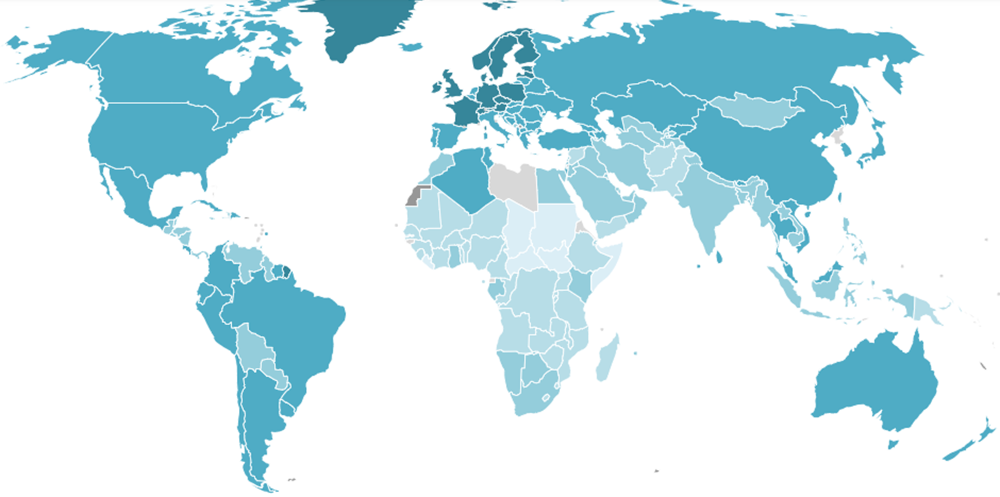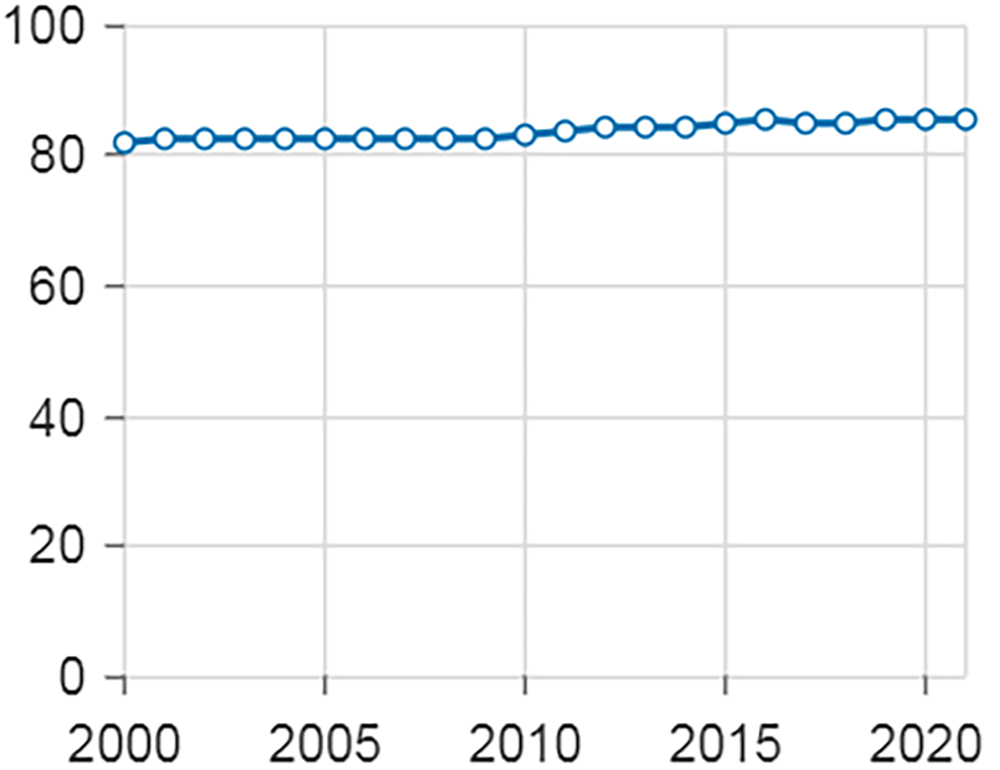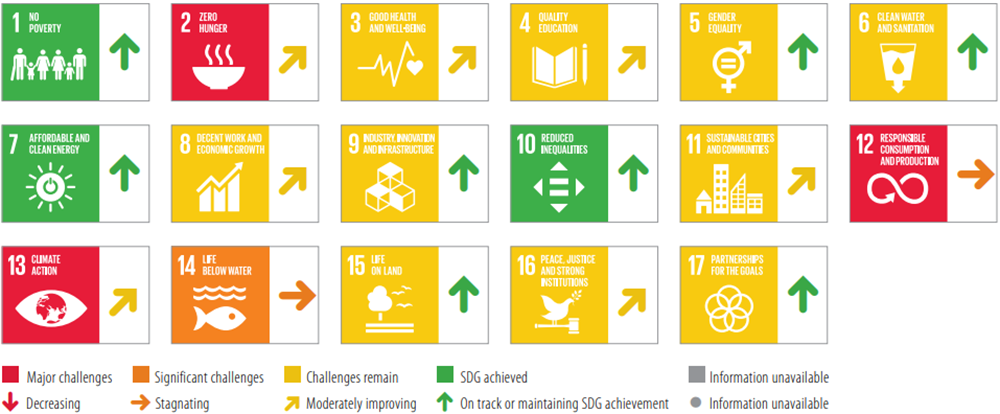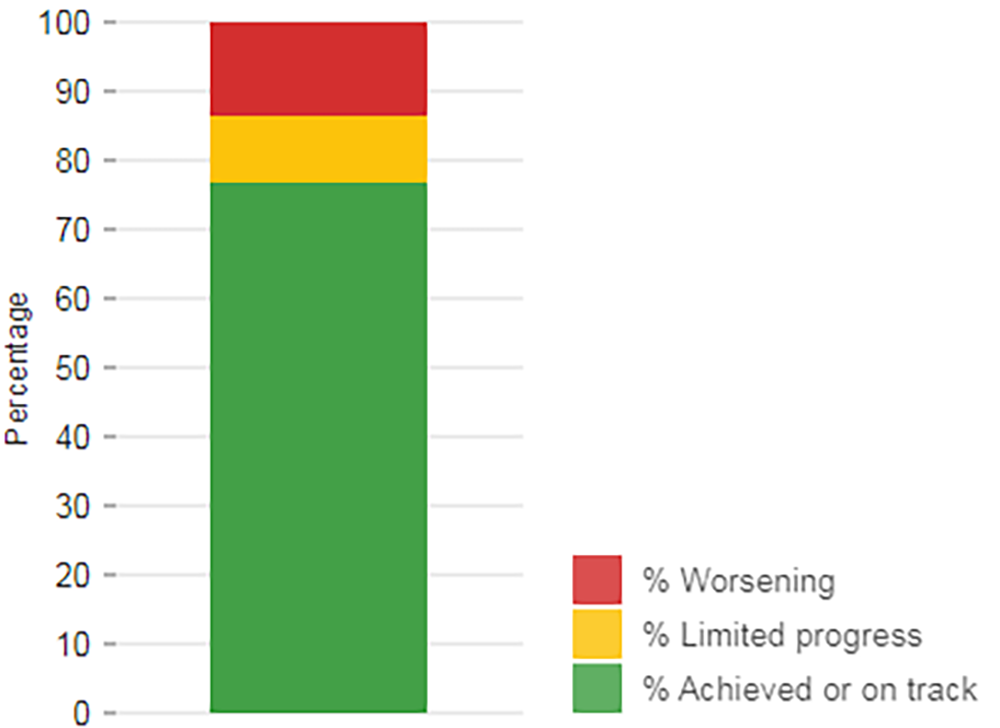Denmark, recognized as a global sustainability leader, consistently ranks highly in sustainability rankings due to its commitment to environmental protection, social responsibility, and innovative technologies. This dedication has resulted in substantial progress in reducing carbon emissions and transitioning to renewable energy sources. Denmark's success is attributed to its effective environmental policies, its emphasis on green innovation, and the engagement of its educated population. By examining Denmark's performance in different areas of sustainability, this analysis aims to provide insights into the country's strengths and challenges in achieving a more sustainable future.
To ensure international comparability, this assessment builds on the global indicator framework and relies on data sourced from the SDG Global Database and OECD databases. The initial figure illustrates the global progress made towards achieving the SDGs. Countries are classified into five distinct categories based on their overall scores, with each category being visually distinguished from the others.
Figure 1. Global overview of the SDGs achievement.
Source: SDSN (2022), Overall score map, SDSN, France, Paris.
The figure reveals that Nordic countries, including Denmark, Norway, Sweden, and Finland, along with some Central, East and West European countries such as Germany, the UK, France, Poland, Austria, the Czech Republic, Latvia, and Estonia, attain the highest scores in the index. Many major countries achieve moderately high results, including the USA, Mexico, Canada, Brazil, Russia, China, and Australia, with Algeria being the sole African country to obtain an overall score above 70. Conversely, the index highlights the lowest scores for some of the least developed countries in Africa, specifically Chad, Sudan, South Sudan, the Central African Republic, and Somalia. The findings highlight a substantial disparity in sustainability levels between developed and less-developed regions. Recognizing and tackling regional variations is of paramount importance in the formulation of global sustainability policies. International collaboration and assistance play a vital role in advancing sustainability in less developed countries, encompassing financial aid, technical expertise, and knowledge exchange. Developed nations bear a greater responsibility for their environmental footprint and should make enhanced contributions to the global sustainability agenda by championing sustainable practices and investing in renewable energy. Addressing the discrepancy in sustainability levels necessitates collaborative efforts among all countries and stakeholders.
The second figure presents Denmark's rankings in terms of its SDG Index, spillover, and Leave No One Behind (LNOB) scores.
Figure 2. Denmark's sustainability rankings.
 Source: Sachs, Jeffrey; Guillaume, Lafortune; Christian Kroll; Grayson Fuller; Finn Woelm (2022), From Crisis to Sustainable Development: the SDGs as Roadmap to 2030 and Beyond, Sustainable Development Report 2022, Cambridge University Press, Cambridge, UK, page 176.
Source: Sachs, Jeffrey; Guillaume, Lafortune; Christian Kroll; Grayson Fuller; Finn Woelm (2022), From Crisis to Sustainable Development: the SDGs as Roadmap to 2030 and Beyond, Sustainable Development Report 2022, Cambridge University Press, Cambridge, UK, page 176.
Denmark has secured the second-highest rank out of 163 countries evaluated in the survey, with an overall SDG Index score of 85.6, which measures progress towards achieving all 17 SDGs. This score represents a percentage of SDG achievement, where a score of 100 implies that all SDGs have been accomplished. The Spillover Index gauges a country's actions' impacts on other countries' SDG achievements along three dimensions: environmental and social impacts embodied in trade, economy and finance, and security. A higher score suggests that a country causes more positive than negative spillover effects. Despite its moderate global ranking, Denmark has more positive than negative spillover effects, as indicated by its spillover score of 66.2. The SDGs are underpinned by the principle of "leave no one behind" (LNOB), and the Leave-No-One-Behind Index tracks inequalities across four dimensions: poverty, services, gender, and income. A higher score signifies fewer population groups being left behind. Denmark's score of 83.6 puts it among the top-ranked countries in terms of addressing these four dimensions of inequality.
The following figure depicts the longitudinal trajectory of Denmark's aggregate SDG Index score.
Figure 3. Overall SDG Index score 2000-2022.
Source: SDSN (2022), Overall score: Denmark, SDSN, France, Paris
The empirical evidence shows that Denmark has consistently sustained a high SDG Index score over the course of 22 years, exhibiting a marginally positive trend. The sustained high performance of Denmark on the SDG Index demonstrates the country's steadfast commitment to sustainable development. However, the marginal positive trend in the score shows that Denmark is continually striving to achieve the SDGs, as some objectives remain unfulfilled and require further improvements. This highlights the need for Denmark to maintain its momentum towards sustainability and continually work towards improving its sustainability performance. This may involve implementing new policies and initiatives to address areas where the country still needs to make progress.
The subsequent figure delves into a more comprehensive scoring of Denmark's sustainability profile, depicting SDG trends in Denmark across all 17 SDGs and signifying the existence of significant or major challenges as well as the attainment of specific SDGs. The trends are classifiable as decreasing, moderately improving, stagnating, on track, or SDG achievement maintenance.
Figure 4. SDG trends in Denmark.
Source: Sachs, Jeffrey; Guillaume, Lafortune; Christian Kroll; Grayson Fuller; Finn Woelm (2022), From Crisis to Sustainable Development: the SDGs as Roadmap to 2030 and Beyond, Sustainable Development Report 2022, Cambridge University Press, Cambridge, UK, page 176.
The figure reveals that Denmark has attained full realization of three out of 17 SDGs (SDGs 1, 7, and 10), and it is also on track or sustaining achievement of five other goals (SDGs 5, 6, 9, 15, and 17), albeit with certain challenges still in place. This means that Denmark has eradicated poverty, provided affordable and clean energy, and reduced inequalities. SDG 14 presents significant challenges, with progress stagnating.
Conversely, smaller challenges persist in relation to the achievement of SDGs 3, 4, 8, 11, and 16, where Denmark is making moderate improvements. Denmark faces major challenges related to only three SDGs (2, 12, and 13), where progress is either stagnating or moderately improving. Therefore, the findings imply that Denmark's sustainable development journey is progressing in the right direction, but there is still much to be done to address the remaining challenges and achieve the SDGs. The country needs to focus on goals such as zero hunger, responsible consumption and production, and climate action. To address the challenge of zero hunger, Denmark needs to focus on reducing food waste, promoting sustainable agriculture practices, and enhancing food security in vulnerable communities. For responsible consumption and production, Denmark needs to continue to promote sustainable consumption patterns, reduce the environmental impact of production processes, and encourage the adoption of circular economy principles. Lastly, to address the challenge of climate action, Denmark needs to continue to reduce greenhouse gas emissions, develop renewable energy systems, and enhance climate change adaptation measures.
The ensuing figure illustrates the score assigned to Denmark regarding its international spillover effects.
Figure 5. International spillover index.
 Source: Sachs, Jeffrey; Guillaume, Lafortune; Christian Kroll; Grayson Fuller; Finn Woelm (2022), From Crisis to Sustainable Development: the SDGs as Roadmap to 2030 and Beyond, Cambridge University Press, UK, page 176.
Source: Sachs, Jeffrey; Guillaume, Lafortune; Christian Kroll; Grayson Fuller; Finn Woelm (2022), From Crisis to Sustainable Development: the SDGs as Roadmap to 2030 and Beyond, Cambridge University Press, UK, page 176.
Denmark's spillover index score is moderate at 66.2 out of 100. Factors contributing to this score include high consumption patterns, resulting in environmental pressures and carbon footprints, historical greenhouse gas emissions, an interconnected global economy, and exposure to environmental risks from other countries. These challenges hinder Denmark's sustainability efforts, as they may be undermined by unsustainable practices in other countries. Additionally, political will, institutional capacity, and societal norms influence the spillover index. Other OECD countries face similar challenges in achieving sustainability goals. In contrast, Oceania and Sub-Saharan Africa have higher spillover index scores due to their lesser integration into the global economy and lower carbon footprint, resulting in fewer negative spillovers.
The following figure shows rankings of European countries in relation to Leave No One Behind Index.
Figure 6. Leave No One Behind Index (100 - highest; 0- lowest).
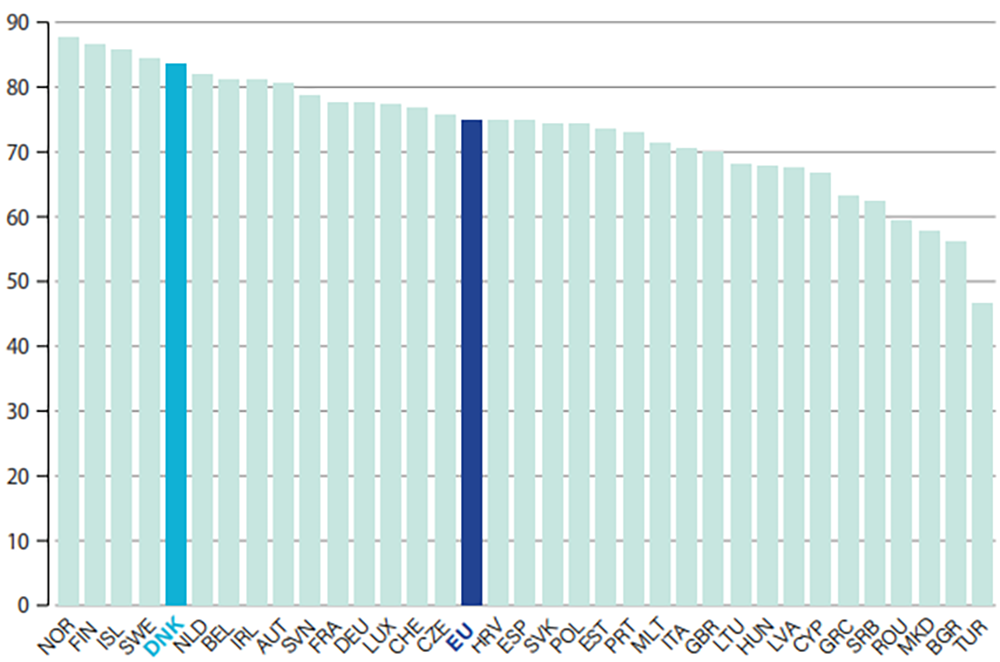
Source: Lafortune, Guillaume; Fuller, Grayson; Bermont-Diaz, Leslie; Kloke-Lesch, Adolf; Koundouri, Phoebe;Riccaboni, Angelo (2022), Achieving the SDGs: Europe’s Compass in a Multipolar World, Europe Sustainable Development Report 2022, SDSN and SDSN Europe, Paris, France, page 124.
Denmark ranks fifth in the index, behind Norway, Finland, Iceland, and Sweden. It outperforms the European Union average, while countries like Turkey, Bulgaria, North Macedonia, and Romania have lower scores. Denmark's high score reflects its efforts to reduce inequalities in poverty, services, gender, and income. The country's strong welfare state ensures access to healthcare, education, and social security. Policies promoting gender equality, such as parental leave and affordable childcare, contribute to reducing gender disparities. However, challenges remain in achieving SDG 2 (zero hunger), and SDG 12 (responsible consumption and production), and SDG 13 (climate action). In its Voluntary National Review, the Danish Government (2021) emphasizes involving and empowering vulnerable groups to identify practical solutions. It acknowledges the need for sustained political strategies to address inequality, enhance opportunities for individuals with disabilities, support vulnerable members of society, ensure equity, and promote the growth and development of children and young people.1
The subsequent figure illustrates the current status of SDG targets in Denmark, presenting trend indicators in percentage format. It provides an overview of the level of attainment for the SDGs, indicating the proportion of targets achieved, as well as those with limited progress or deteriorating outcomes.
Figure 7. Status of SDG targets for Denmark (% trend indicators).
Source: SDSN (2022), Europe Sustainable Development Report 2022, SDSN, Paris, France.
The figure demonstrates Denmark's progress towards achieving the SDG targets, as presented through the trend indicators indicating the percentage of SDG targets achieved. The results illustrate that Denmark has achieved or is on track to achieve 75–80% of the SDG targets, with limited progress in accomplishing 5-10% of targets and worsening outcomes for 10–12% of targets. This progress reflects a noteworthy achievement, as the majority of targets have been met or are on track to be met, and progress is being made towards other targets. Nonetheless, it is evident that certain targets require greater attention, and overcoming significant challenges remains necessary for Denmark to fully implement the 2030 Agenda. Consequently, addressing these challenges will necessitate not only changes in formal regulations but also shifts in social behaviors towards responsible consumption and production, and actions related to SDG 14: "Life below water," considering Denmark's heavy reliance on its water resources for economic development.
The forthcoming figure 11 presents a comprehensive summary of Denmark's performance across the SDG targets, highlighting its notable strengths and challenges.
Figure 8. Denmark’s distance from achieving SDG targets.
Source: OECD (2022), Measuring distance to the SDG targets - Denmark, OECD, Paris, France, page 1.
According to the figure, Denmark has already accomplished 25 of the 129 SDG targets for which comparable data is available, and it is anticipated to achieve 7 more targets by 2030 based on recent trends. For example, Denmark has low levels of inequality (goals 1 and 10), prioritizes environmental issues, and excels in ensuring fundamental rights and conducting extensive consultations with stakeholders and within government (goal 16). Denmark exhibits strengths in low inequality and poverty, supported by a robust redistributive system and comprehensive social protection coverage. The country has made significant strides in transitioning to an energy-efficient, low-carbon economy with a substantial reliance on renewable energy sources. Denmark also demonstrates a strong commitment to preserving terrestrial and marine biodiversity. However, challenges persist in achieving inclusion targets, such as promoting female representation in leadership roles and addressing responsible migration. Environmental pressures from the agricultural sector, including excessive nitrogen inputs, hinder progress in preserving local breeds and water-related ecosystems. Denmark also faces challenges in reducing food waste and achieving targets for education on sustainable development (OECD, 2022).2
The indicators presented in this article are utilized to pinpoint the strengths and shortcomings of Denmark's sustainability profile. This approach enables us to gauge the extent to which Denmark has progressed in achieving the SDGs. Building on these findings, further research can be conducted to gain a deeper understanding of the country's policies, including its economic diplomacy strategy.
References
1 The Danish Government (2021), Voluntary National Review 2021, Ministry of Finance, Copenhagen, Denmark.
2 OECD (2022), Measuring distance to the SDG targets - Denmark ), OECD, Paris, France, page 1.
3 Lafortune, Guillaume; Fuller, Grayson; Bermont-Diaz, Leslie; Kloke-Lesch, Adolf; Koundouri, Phoebe;Riccaboni, Angelo (2022), Achieving the SDGs: Europe’s Compass in a Multipolar World, Europe Sustainable Development Report 2022, SDSN and SDSN Europe, Paris, France, page 124.
4 Sachs, Jeffrey; Guillaume, Lafortune; Christian Kroll; Grayson Fuller; Finn Woelm (2022), From Crisis to Sustainable Development: the SDGs as Roadmap to 2030 and Beyond, Sustainable Development Report 2022, Cambridge University Press, Cambridge, UK, page 176.
5 SDSN (2022), Europe Sustainable Development Report 2022, SDSN, Paris, France.
6 SDSN (2022), Overall score map, SDSN, France, Paris.
7 SDSN (2022), Overall score: Denmark, SDSN, France, Paris.
8 The Danish Government (2021), Voluntary National Review 2021, Ministry of Finance, Copenhagen, Denmark.

